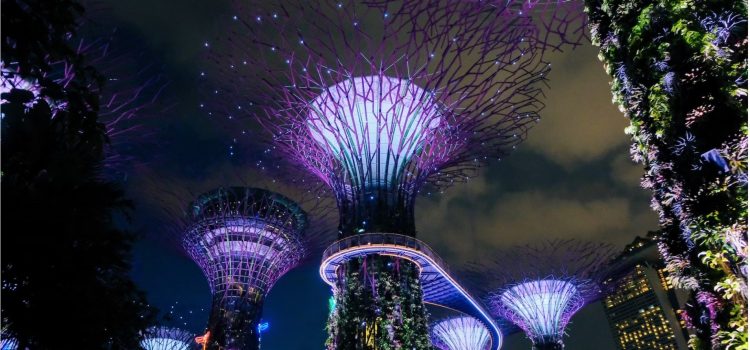
This is a free excerpt from one of Shortform’s Articles. We give you all the important information you need to know about current events and more.
Don't miss out on the whole story. Sign up for a free trial here .
What will the future cities of the world look like? How will we tackle issues like climate change and overpopulation?
The world’s urban population is increasing rapidly, especially in the developing world. The proposed solutions to future urban challenges include revegetation, wind gardens, green rooftops, cable cars, smart traffic lights, and underground developments.
Read on for examples of how the future cities of the world might be different than today’s urban cities.
The Future Cities of the World
What will the future cities of the world look like? Many new cities are being planned and built around the world. These cities give us the chance to start all over again in creating solutions for climate change, transportation, and space constraints.
To deal with rising sea levels, city designers are creating floating cities or relocating existing ones. They’re also seeking novel transportation arrangements, such as car-free cities, electric “ground to air” vehicles, and hyperloops. And they’re getting around space constraints by building vertically or going under the sea. However, most of these solutions will only work for a limited number of people. We need to find ways to make sure that the world’s poorest don’t get left behind.
In this article, we’ll look at how we’re planning to retool our existing cities to tackle future challenges in addition to the plans we’re making for the future cities of the world, which will tackle these same issues.
Keeping Cool With Climate Change
The most immediate effect of climate change will be increasing temperatures. Cities trap heat, creating urban heat islands that will intensify any global heating effects. With recent global heat waves becoming the new normal, how will the future cities of the world stay cool?
Greening Urban Areas
Vegetation is surprisingly powerful in mitigating the heat island effect—so the simplest cooling solution is planting more trees. Paris and Bangkok, for example, are planning vast new urban parks, while a “pocket park” initiative in Athens is greening abandoned urban lots. A revamped Toronto waterfront will feature a mass timber (compressed wood) building with forested rooftops and balconies.
Drawing on Traditional Knowledge
Some city planners are seeking inspiration from cultures that know what they’re doing when it comes to heat. Architects in Delhi and around the world, for example, are exploring the use of traditional Indian lattices (jaali) to encourage breezes to flow through new buildings. A giant wind garden in Madrid, which is hoped to cut the city’s daytime temperature by as much as 4°C (7°F) upon its opening in 2025, will have a spiral structure inspired by traditional Middle Eastern wind-catching techniques.
Developing New Cooling Technologies
The roads and sidewalks in China’s “sponge cities” are built from newly developed porous materials that can capture, filter, and store water for later use. As an added benefit, these materials also decrease both surface and air temperatures. Singapore is moving in another direction, exploring energy-saving district-level cooling systems (designed to replace individual air conditioners) and creating a digital twin (a city model) to explore cooling options using big data.
Floating Cities
While we can offset some aspects of climate change by adapting the cities we already have, other aspects are much more difficult to solve on the run. Rising sea levels, for example, will eventually see many of the world’s coastal cities flooded. Floating cities are one proposed solution. The Maldives, which is on track to lose 77% of its land area by 2100, is building a floating city with a layout inspired by the structure of brain coral. The above-water part will be home to 5,000 people, while the underwater part will be designed to encourage coral growth.
Relocation
Another solution to rising seas is to simply move to higher ground. With parts of Indonesia’s capital Jakarta (population 10.5 million) sinking due to depleted groundwater and increasingly susceptible to sea level rises, the Indonesian government has begun construction on a new capital, Nusantara, that’s due for completion in 2045. Nusantara is envisioned as a green, sustainable city and a regional economic hub.
Tackling Urban Transportation
We all know that cars cause congestion and environmental damage. But replacing them with public transport can be tricky: Trains, for example, are expensive and difficult to build through already inhabited areas. Cable cars may be a potential solution. As well as keeping the roads clear, cable cars take up less space than railroads and can be constructed much more cheaply.
In South America, Medellín’s Metrocable and La Paz’s teleférico have relieved road congestion while also connecting poorer neighborhoods with the rest of the city, leading to a reduction in socioeconomic inequality. Other cities are taking note: Paris will start work on a cable car line this year (expected completion 2025), while Gothenburg, Jerusalem, Mombasa, and Chicago are considering, planning, or actively building new systems.
Accessibility
The plans for most future cities of the world either drastically reduce the number of cars or do away with them entirely. BiodiverCity, a planned development on reclaimed land in Penang, Malaysia, will feature artificial islands in the form of “urban lilypads” that are fully connected by autonomous transport systems.
New Vehicles
Telosa, a city of 5 million to be built somewhere in the U.S. desert, will feature several novel transport systems. The city’s designers are developing versatile electric “Ground to Air” vehicles that can be fitted with wheels to become cars, rotor blades to become helicopters, and rails for train and hyperloop travel.
Overcoming Space Constraints
In existing cities, urban planning decisions have to work with what’s already there. But in the future cities of the world, we have the freedom to start all over again and get it right this time. But what are the plans to overcome future space constraints in large, urban cities?
Underground Cities
Given that most of the technology we need to build underground is already available or will soon be, there are surprisingly few plans for underground developments. Aside from a couple of underground agricultural projects in London and New York, we haven’t experimented much beneath the surface: maybe because of the cost, maybe because we don’t like it much down there, and maybe because it’s unclear who owns underground spaces.
The most intriguing proposed underground development is Mexico City’s Earthscraper, an inverted pyramid (inspired by the Aztec pyramids) to be driven 65 stories into the ground under the city center. Unfortunately, however, the $800 million price tag and location in a known earthquake zone mean that it’s not likely to become reality anytime soon.
Vertical Cities
When most of our current cities were designed and built, skyscraper technology wasn’t well developed. But the future cities of the world can take advantage of advances in construction that open up the possibility of vertical cities. While no true vertical cities have been green-lit so far, the 632 m (2,000 feet) tall Shanghai Tower and its sky lobbies give us a sense of what one might look like.
Undersea Cities
We could also go underwater. We already have the technology to build underwater colonies of up to 100 people, and submarine-like technology could be used to build settlements that submerge and resurface periodically for natural light. On the other end of the population scale is Liam Young’s Planet City thought experiment, a “hyper-dense metropolis” that can house 10 billion people.
Who Gets Left Behind?
While the global urban population is on track to be 6.4 billion in 2050, growth in the developed world will be relatively flat: Between 2005 and 2050, cities in developed countries will grow steadily from 900 million to 1.1 billion, while cities in developing countries will balloon from 2.2 billion to 5.3 billion over the same period. This means that while pocket parks and cable cars might work in the developed world, developing countries will need bolder solutions.
The Maldives Floating City, for example, will house 20,000 people, or only 3.7% of the population of a country that’s set to lose 77% of its area. And the population target for Indonesia’s replacement capital Nusantara is 1.7 to 1.9 million in 2045, while the projected population of Jakarta in that year is over 15 million.
Where will the other 13 million go when their city is underwater? And how do we make sure that the poorest aren’t left behind?

Want to fast-track your learning? With Shortform, you’ll gain insights you won't find anywhere else .
Here's what you’ll get when you sign up for Shortform :
- Complicated ideas explained in simple and concise ways
- Smart analysis that connects what you’re reading to other key concepts
- Writing with zero fluff because we know how important your time is






